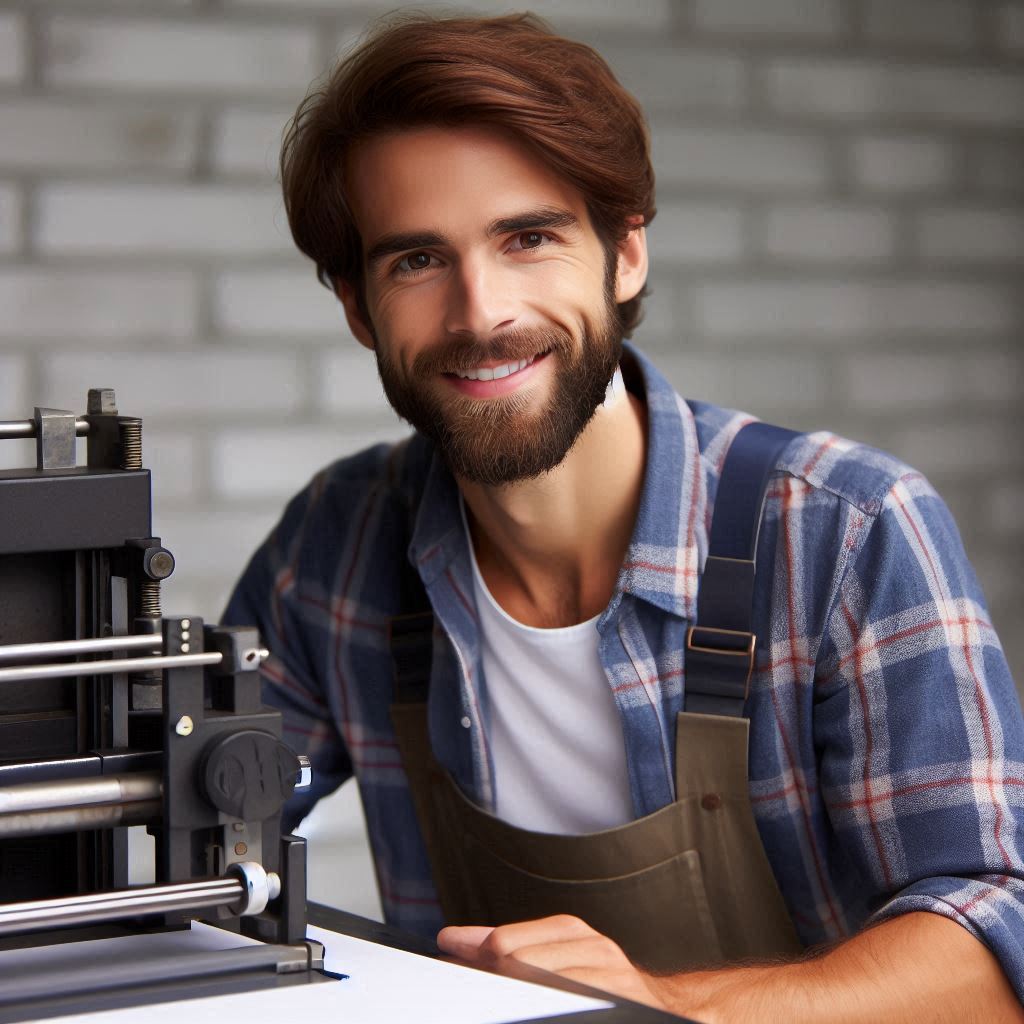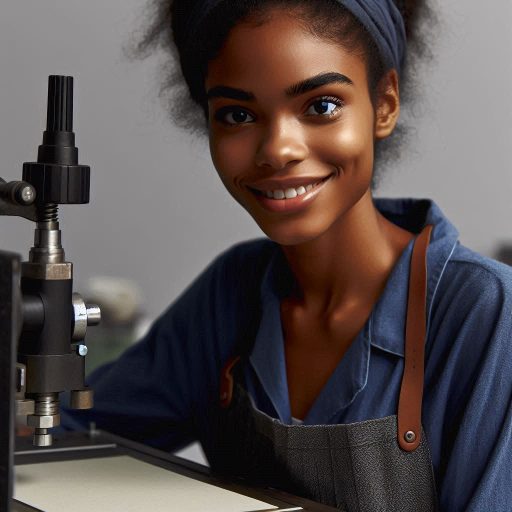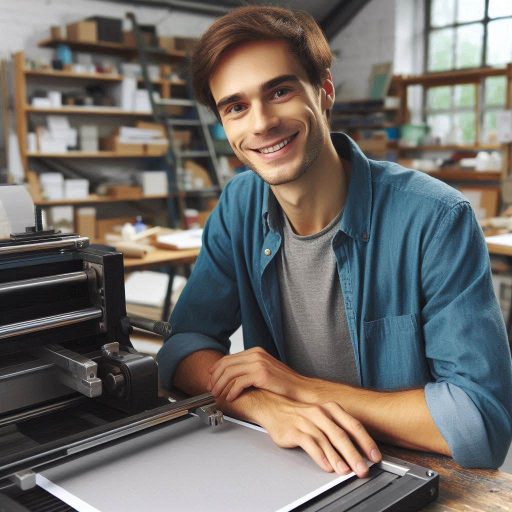Introduction
Photogravure is a printmaking technique that combines photography and etching to produce high-quality prints.
It involves transferring a photographic image onto a copper plate using light-sensitive materials.
The plate is then etched, creating grooves that hold ink.
Once inked, the plate is pressed onto paper, resulting in a richly detailed print.
Photogravure is known for its ability to capture fine details and subtle tonal variations.
Understanding different printmaking techniques, such as photogravure, is essential for artists and print enthusiasts.
Each technique offers unique results and artistic possibilities.
Knowing how these methods work allows artists to choose the best technique for their creative vision.
Photogravure, in particular, offers a versatile way to reproduce photographic images while maintaining an artistic touch.
By learning about various printmaking techniques, artists expand their skill sets and creative opportunities.
It also fosters a deeper appreciation for the craftsmanship behind each print.
Photogravure, with its complex yet rewarding process, remains a popular choice among fine art printmakers.
The technique bridges photography and traditional printmaking, offering a unique way to explore visual storytelling.
Understanding photogravure opens doors to new artistic possibilities and enhances creative expression.
History of Photogravure
Photogravure, a printmaking technique that combines photography and intaglio printing, has a rich history that dates back to the 19th century.
The process of creating a photogravure involves transferring a photographic image onto a copper plate for printing.
Origins of Photogravure
The photogravure process was invented by French photographer Henry Fox Talbot in the 1850s as a means of reproducing photographic images in print form.
The technique allowed for the production of high-quality prints with subtle tones and fine details.
Photogravure quickly gained popularity among photographers and printmakers for its ability to accurately reproduce photographs in print form.
The process involves etching a photographic image onto a copper plate through a series of chemical processes, resulting in an intaglio plate ready for printing.
Transform Your Career Today
Unlock a personalized career strategy that drives real results. Get tailored advice and a roadmap designed just for you.
Start NowDevelopment of the Technique over Time
Throughout the 19th and 20th centuries, photogravure continued to evolve and improve, with advancements in technology and techniques leading to the refinement of the process.
Printmakers experimented with different materials, chemicals, and methods to enhance the quality and detail of photogravure prints.
Photogravure became widely used in the printing industry for reproducing fine art prints, illustrations, and photographs.
The technique’s ability to capture subtle tones and textures made it a popular choice for artists seeking to produce high-quality prints with a rich, velvety appearance.
In contemporary times, photogravure has experienced a resurgence in popularity among artists and printmakers who are drawn to its unique aesthetic qualities and tactile nature.
The process of creating a photogravure print involves a combination of traditional printmaking techniques and digital technology, allowing for the creation of prints with exceptional detail and depth.
Overall, the history of photogravure reflects the enduring appeal of this printmaking technique and its ongoing relevance in the world of fine art and printmaking.
From its origins in the 19th century to its modern-day applications, photogravure continues to captivate artists and enthusiasts with its distinctive beauty and timeless elegance.
Read: How to Participate in Printmaking Competitions
Materials Needed for Photogravure
Essential Materials Needed for Photogravure
- Copper plates
- Light-sensitive emulsion
- Ink
- Press
Photogravure is a printmaking technique that involves transferring photographic images onto a copper plate.
Step-by-Step Process
- Prepare the Copper Plate: Clean the copper plate thoroughly to ensure there is no dirt or grime that could affect the image transfer.
- Apply Light-Sensitive Emulsion: Coat the copper plate with a light-sensitive emulsion and let it dry in a darkroom to avoid exposure to light.
- Expose the Image: Place a transparency of the image you want to transfer onto the emulsion-coated copper plate and expose it to light.
- Develop the Plate: After exposure, develop the plate using appropriate chemicals to reveal the transferred image.
- Print the Image: Apply ink to the copper plate and wipe off excess ink, leaving the ink only in the engraved areas.
- Transfer the Image: Place the inked plate on the press with a dampened paper on top and run it through the press to transfer the image onto the paper.
Benefits of Using Photogravure
- Produces high-quality, detailed prints
- Allows for a wide range of tones and textures
- Offers a unique and artistic way of reproducing photographs
- Provides a durable and long-lasting final product
In essence, photogravure is a sophisticated printmaking technique that requires precision and attention to detail.
By using the right materials and following the step-by-step process, artists can create stunning prints with intricate details and textures.
Explore the world of photogravure and unleash your creativity in the realm of printmaking.
Read: How to Market Your Glass Art Online
Preparation of Image
When it comes to creating a photogravure print, the image preparation stage is crucial.
Follow these steps to ensure you have a successful transfer onto the copper plate:
Choosing a high-quality photograph
- Start by selecting a photograph that has a good balance of light and shadow, as this will translate well in the final print.
- Look for an image that has a high level of detail and contrast to create a striking photogravure print.
- Ensure that the photograph has a resolution of at least 300 dpi to maintain sharpness in the final print.
Transferring the image onto a transparency
- Once you have chosen the photograph, transfer it onto a transparency using a laser printer or photocopier.
- Make sure to flip the image horizontally before printing it onto the transparency, as this will ensure it is correctly oriented on the copper plate.
- Check the transparency for any smudges or imperfections that could affect the quality of the transfer onto the plate.
Exposing the image onto the copper plate
- Place the prepared copper plate in the exposure unit, ensuring that it is securely held in place.
- Position the transparency with the image side facing down onto the copper plate, aligning it carefully to ensure an accurate transfer.
- Expose the plate to UV light for the specified amount of time, following the recommended exposure guidelines for your particular setup.
- After exposure, carefully remove the transparency and develop the plate using the appropriate chemicals to reveal the etched image.
By following these steps and paying close attention to the image preparation process, you can create stunning photogravure prints with intricate detail and depth.
Read: Famous Printmaking Studios Around the World

Acid Etching Process
When creating a photogravure print, one of the essential processes is acid etching, which involves submerging the plate in an acid bath to achieve the desired image.
The acid etching process is crucial as it helps to etch the image onto the plate, resulting in a detailed and textured print.
Transform Your Career Today
Unlock a personalized career strategy that drives real results. Get tailored advice and a roadmap designed just for you.
Start NowSubmerging the Plate in an Acid Bath
The first step in the acid etching process is preparing the plate by coating it with a light-sensitive emulsion.
The plate is then exposed to light through a photographic negative, transferring the image onto the emulsion.
Once exposed, the plate is submerged in an acid bath, typically consisting of ferric chloride or nitric acid.
As the plate sits in the acid bath, the acid begins to eat away at the exposed areas of the plate, creating grooves that will hold the ink for printing.
The longer the plate remains in the acid bath, the deeper the etching will be.
This process requires careful monitoring to avoid over-etching, which can result in loss of detail or damage to the plate.
Time Required for Etching
The time required for etching varies depending on factors such as the type of acid used, the strength of the etching solution, and the desired depth of the etch.
Generally, etching times can range from a few minutes to several hours.
It is essential to follow the recommended etching times provided by the manufacturer of the acid solution to ensure consistent and accurate results.
Over-etching can lead to a loss of detail and definition in the final print, while under-etching may result in a lack of depth and clarity.
Checking the Progress of the Etching
During the etching process, it is crucial to periodically check the progress of the etch to ensure that the desired image is being achieved.
This can be done by carefully removing the plate from the acid bath at regular intervals and inspecting the depth of the etching.
One common method of checking the progress of etching is by using a magnifying glass or loupe to examine the plate closely.
By observing the grooves and lines created by the acid, the artist can determine whether the etch is progressing as intended.
Adjustments can be made to the etching time if necessary to achieve the desired result.
Overall, the acid etching process is a critical step in creating a photogravure print.
By submerging the plate in an acid bath, monitoring the etching time, and checking the progress of the etch, artists can achieve detailed and textured prints that capture the essence of the original image.
Read: Glass Art Techniques for Beginners
Ink Application
Photogravure is a beautiful printmaking technique that involves transferring photographic images onto a copper plate.
The process can be challenging, but the results are worth it.
Transform Your Career Today
Unlock a personalized career strategy that drives real results. Get tailored advice and a roadmap designed just for you.
Start NowIn this post, we will delve into the ink application process in photogravure.
Ink application is a crucial step in the photogravure process as it determines the quality of the final print.
Here are some key points to keep in mind when applying ink to the plate:
Wiping ink onto the plate
When it comes to applying ink, the first step is to carefully wipe the ink onto the plate.
This should be done in a smooth and consistent motion to ensure even coverage.
When wiping ink onto the plate, it is important to use gentle pressure to avoid damaging the delicate image.
The ink should be spread evenly across the plate to ensure a smooth and consistent print.
Ensuring even coverage
One of the most important aspects of ink application is to achieve even coverage across the entire plate.
This helps in creating a uniform and consistent print.
To achieve even coverage, it is helpful to use a circular motion when wiping the ink onto the plate.
This helps in distributing the ink evenly and prevents any patchy areas on the final print.
Removing excess ink
It is essential to remove any excess ink from the plate before transferring the image onto the paper.
This can be done using a variety of tools such as tarlatan or cloth.
Removing excess ink is crucial to avoid over-inking the plate, which can result in smudges and blurs on the print.
Use a clean cloth or tarlatan to gently wipe away any excess ink from the plate.
By following these steps and paying attention to detail, you can ensure that the ink application process in photogravure is done correctly.
This will result in high-quality prints that accurately replicate the original photographic image.
In general, ink application is a fundamental part of the photogravure process that requires attention to detail and precision. By following the steps outlined above, you can achieve beautiful and consistent prints that showcase the artistry of the photogravure technique.
Printing Process
Placing paper on top of the inked plate
When it comes to printmaking techniques, the final step is the printing process.
This is where the image created on the plate is transferred onto the paper.
Transform Your Career Today
Unlock a personalized career strategy that drives real results. Get tailored advice and a roadmap designed just for you.
Start NowPlacing paper on top of the inked plate is a crucial step in the printing process.
The paper must be carefully positioned to ensure the image will transfer correctly.
Running the plate through a press
Next, the plate with the paper on top is run through a press.
The press applies pressure, allowing the ink from the plate to transfer onto the paper.
Checking for the quality of the print
After running the plate through the press, it is important to check for the quality of the print.
This includes looking for any imperfections or inconsistencies in the image.
By following these steps in the printing process, artists can create beautiful photogravure prints that accurately represent their original image.
Each step plays a key role in achieving a high-quality final product.
Variations in Photogravure Techniques
Photogravure is a versatile printmaking technique that allows for various creative possibilities.
Here are some common variations in photogravure techniques:
Color photogravure
Color photogravure involves using multiple plates for different colors in the printmaking process.
Each plate is etched with a specific color, which when combined, creates a vibrant and multi-dimensional final print.
Artists can experiment with different color combinations and layering techniques to achieve various effects in color photogravure prints.
This variation allows for a wide range of artistic expression and creativity.
Intaglio photogravure
Intaglio photogravure refers to the technique of printing an image from an etched plate using ink.
This process involves the plate being inked and wiped, leaving ink only in the etched areas.
Intaglio photogravure results in prints with rich tonal values and fine details.
Artists can control the depth of the etching to create different textures and effects in their prints, adding depth and dimension to their work.
Experimental techniques
Photogravure allows artists to explore experimental techniques and push the boundaries of traditional printmaking.
Artists can create unique effects by manipulating the plates, inks, papers, and printing processes.
Transform Your Career Today
Unlock a personalized career strategy that drives real results. Get tailored advice and a roadmap designed just for you.
Start NowPhotogravure artists experiment with unconventional materials and techniques.
They explore innovative ways to ink and wipe plates.
They also combine photogravure with other printmaking methods.
This approach creates unique and hybrid prints.
By embracing experimentation, artists can discover innovative ways to incorporate photogravure into their artistic practice, leading to exciting and unexpected results in their prints.
Overall, the variations in photogravure techniques offer artists a diverse range of options to explore and express their creativity in printmaking.
Whether through color photogravure, intaglio photogravure, or experimental techniques, artists can continue to push the boundaries of this centuries-old technique and create unique and captivating prints.
Conclusion
Understanding photogravure basics is essential for mastering this printmaking technique.
It provides a strong foundation for creating high-quality prints.
Further exploring photogravure can involve experimenting with different plate etching methods, such as aquatint or mezzotint, to create unique textures and tones.
Artists can also explore combining photogravure with other printmaking techniques, like lithography or screen printing, to achieve layered and complex artworks.
By understanding the basics of photogravure, artists can push the boundaries of what is possible within this medium and create innovative and intriguing prints.




